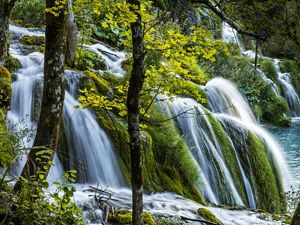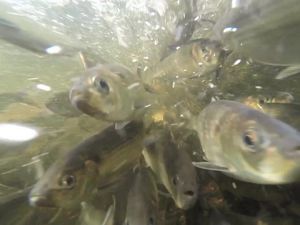Freeing the Green River
Removing defunct dams restores natural flows and gives people and wildlife new opportunities to benefit from a healthy river.
The natural flow of a river resembles a healthy human heartbeat. Heavy rains send pulses of water downstream in spring, flushing side channels and signaling fish to spawn. Dry stretches in summer allow seedlings to take root. Dams and other man-made structures can change these rhythms. The beat of a heavily dammed river can look almost like a flatline, causing natural systems to suffer.
The fall of 2024 marked the time when Kentucky’s iconic Green River reclaimed its heartbeat.
For more than a decade, TNC has worked closely with the U.S. Army Corps of Engineers, the U.S. Fish and Wildlife Service, Mammoth Cave National Park, and other partners to strategically remove aging locks and dams that posed a risk not only to nature but to people. Then, one beautiful September day under postcard blue skies, the final piece of the last lock and dam of this project was removed.

“It was an incredible moment to see the largest river restoration project in the history of Kentucky come to fruition,” said Danna Baxley, TNC’s director of conservation in Kentucky. “We’re already seeing benefits for the more than 150 fish species and 70 species of mussels that call the river home, and we are continuing to work with local communities on issues including public access.”
Quote: Danna Baxley
"It was an incredible moment to see the largest river restoration project in the history of Kentucky come to fruition."
Dam removals benefit nature and people
People navigated the Green for commerce in pioneer days. In the early 20th century, locks and dams were built on the river and its tributaries—and eventually its headwaters—to aid in commercial navigation. This significantly changed the river’s natural pulse.
“Fish population surveys have clearly shown that the number and health of sportfish in free-flowing sections of the Green River are far superior to its impounded pools,” explained Baxley. “Water contained in the pool upstream of a dam is more like a pond than a flowing river. Once the dam is removed, the water will once again take on the natural characteristics of a free-flowing river system, which will result in improved fishing for freshwater species like the smallmouth bass.”
In addition to degrading habitat and affecting wildlife, the decades-old structures were showing signs of age and decline that threatened public safety. Paddlers ran the risk of being swept over a low-head dam, while bank erosion along parts of the river compromised drinking water supplies further downstream.
History of Green River Lock and Dam #6
Quote: David Phemister
“Almost a decade ago, we convened a stakeholder meeting at Mammoth Cave National Park to discuss potential dam removals. That meeting helped build trust among the partners and was a critical early step in this long journey.”
Igniting the Power of Partnership
“Almost a decade ago, we convened a stakeholder meeting at Mammoth Cave National Park to discuss potential dam removals,” said David Phemister, TNC state director in Kentucky. “That meeting helped build trust among the partners and was a critical early step in this long journey.”
Everyone in attendance wanted a healthier, safer and more accessible Green River. It was also clear the community strongly opposed removing one of the structures in question, so together, attendees co-created a list of which locks and dams to target for removal. They also realized they had a powerful ally in Senator Mitch McConnell, who saw the deteriorating structures as a growing problem that needed a lasting solution.
Having Senator McConnell’s support was essential because starting the project required two rounds of enabling legislation and increased funding for the U.S. Fish and Wildlife Service’s dam removal program. Getting all the puzzle pieces in place took strong advocacy from TNC and patience and persistence from the partners.

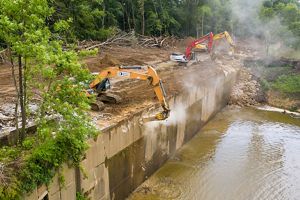
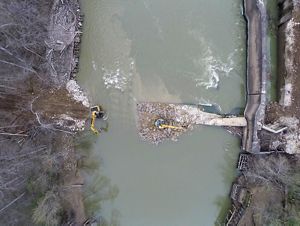
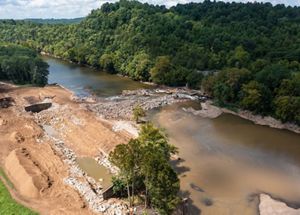
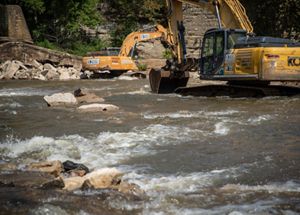
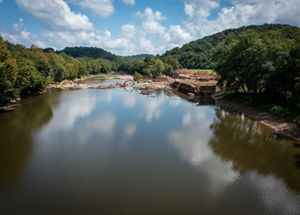
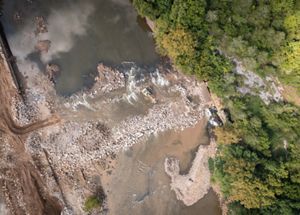
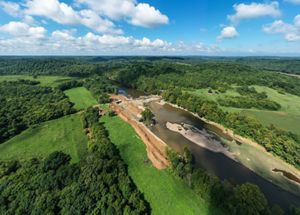
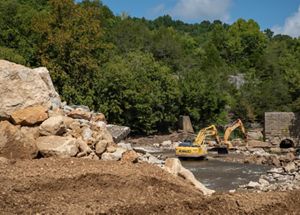
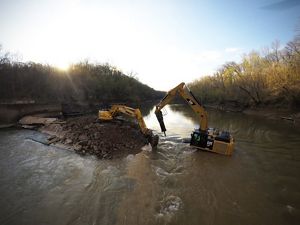

Green River Lock and Dam #5: Lock and Dam #5 as seen before the beginning of the removal process in the summer of 2021. © Mike Wilkinson
1 of 10

Green River Lock and Dam #5: Lock and Dam #5 as seen at the beginning of the removal process in the summer of 2021. © Mike Wilkinson
2 of 10

Lock and Dam Removal: Green River Lock and Dam #6 was removed in March, 2017. © Philip Scott Andrews
3 of 10

Overhead of the Lock and Dam: A view from above of the work being done at Lock and Dam to restore a stretch of free flowing river. © Mike Wilkinson
4 of 10

At Work on Removal: Two enormous excavators are used to remove the old concrete that made up the former Lock and Dam #5 on the Green River. © Mike Wilkinson
5 of 10

6 of 10

7 of 10

8 of 10

Debris Removal: Removing a lock and dam has its inherent difficulties but the excavators work hard to remove debris and help restore the river. © Mike Wilkinson
9 of 10

Green River Lock and Dam #6: Green River Lock and Dam #6 was removed in March, 2017. © Philip Scott Andrews
10 of 10
The final dam on the list was removed in 2024, connecting 198 miles of free-flowing river—by far the largest river restoration project in Kentucky’s history.
“Now, fish and other aquatic species will have the healthy habitat they need to thrive, and visitors to Mammoth Cave National Park can safely paddle past Brownsville, with no in-stream barriers between Mammoth Cave and the Rochester Dam,” said Baxley.
“This boost to local wildlife and tourism benefits the ongoing Green River Blueway and Trail Town initiatives, which have been embraced by towns along the Green River and the Barren River Area Development District (BRADD).”

What’s next for the Green River?
We are now working to expand wetland restoration to the Lower Green River, working to enroll frequently flooded farmland into permanent conservation easements, and restore native forest and wildlife habitat. The Lower Green is one of the largest contributors to nutrient pollution in the Ohio River basin and historically has seen lower adoption of conservation incentives than other parts of the state.
Additionally, we have an emerging opportunity to address the health and connectivity of critical freshwater streams in the heart of Kentucky’s Appalachian Mountains. Using the best available science, we are focused on improving stream crossings and removing barriers to the movement of fish and other species while also reducing flood risk, enhancing water quality, and improving recreational access.

Modernizing water infrastructure to maximize benefits
With just 2 percent of the three million miles of rivers and streams in the U.S. still free-flowing and undeveloped, the survival of freshwater systems hinges on our ability to reduce the negative impacts of river infrastructure. That’s why TNC and the U.S. Army Corps of Engineers—the largest water manager in the nation—launched a collaborative effort called the Sustainable Rivers Program to find smarter ways to manage river infrastructure to optimize benefits for people and nature. It began on Kentucky’s Green River, and the collaboration has grown to include dozens of rivers.
We Can’t Save Nature Without You
Sign up to receive monthly conservation news and updates from Kentucky. Get a preview of Kentucky's Nature News email.
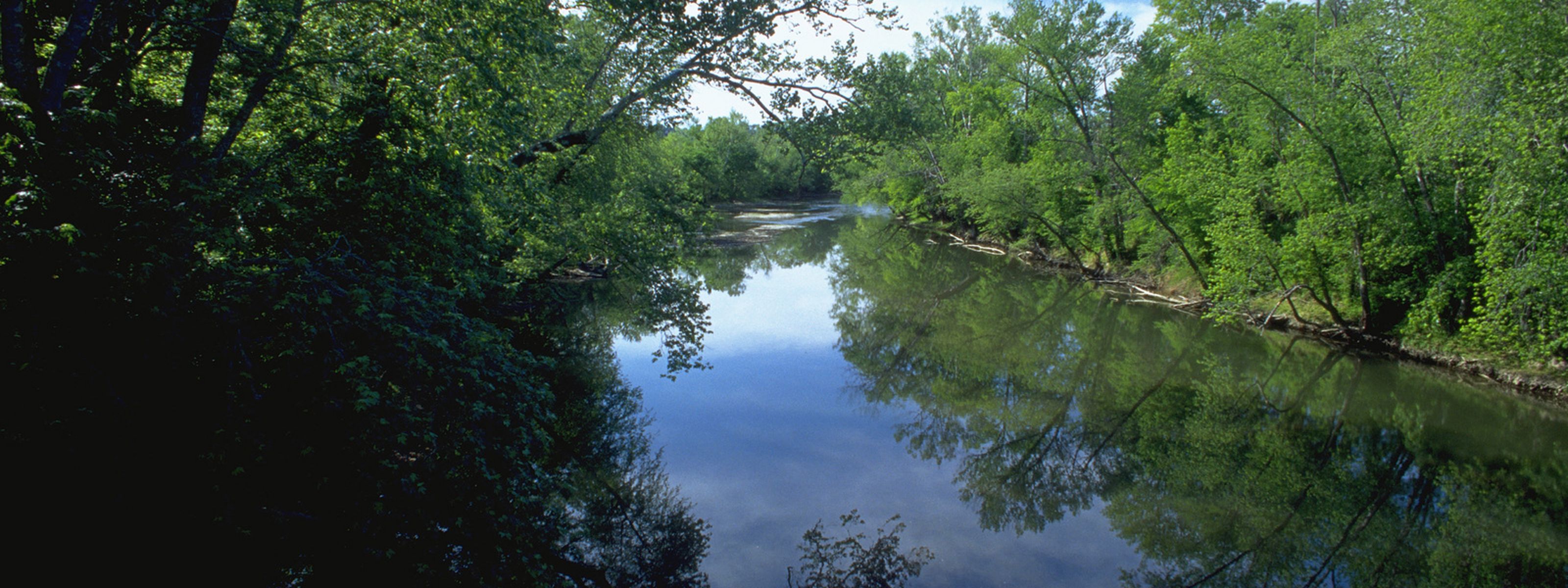
Stand Up For Nature
Support our work to protect nature in Kentucky.
















